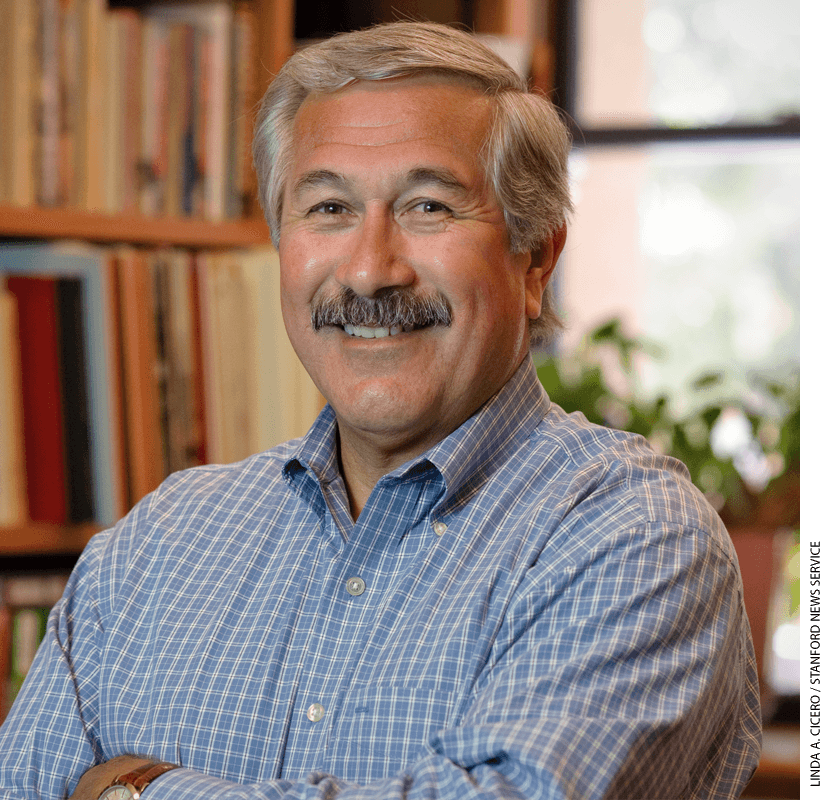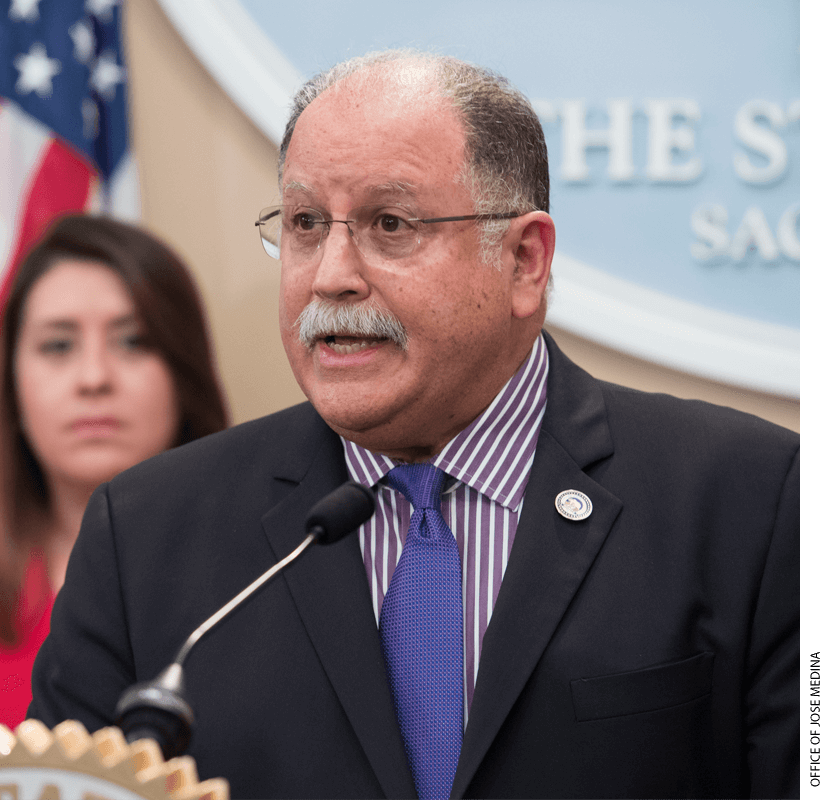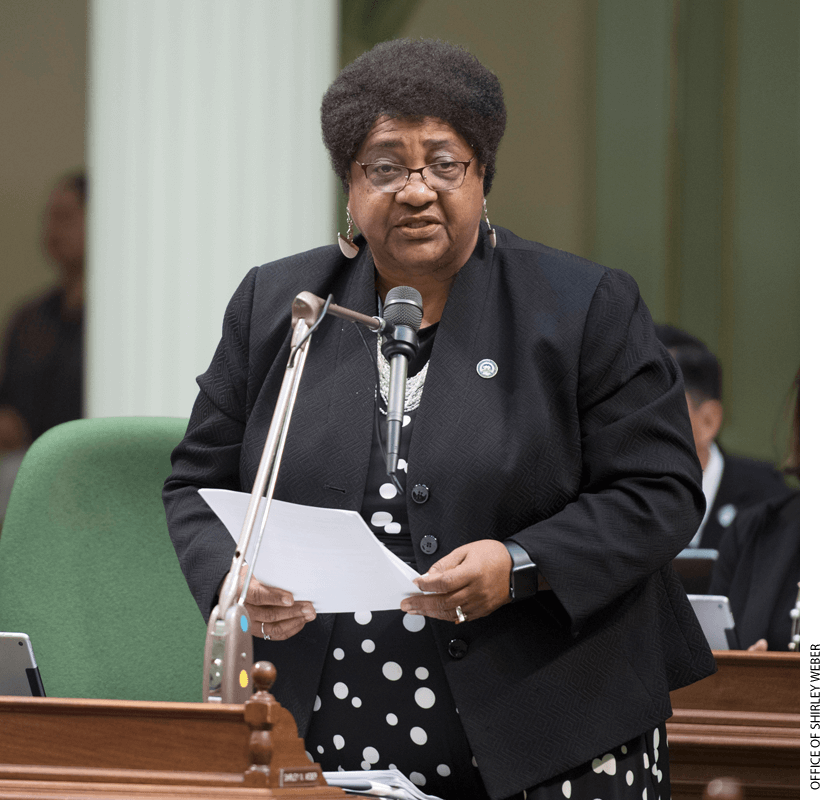 Among California’s many distinctions, the state stands out for the minimal requirements it imposes for high-school graduation, among the most lenient in the United States. California is one of a handful of states that require just three years of English and two years of math to earn a high-school diploma. The last revision to the list of 13 required courses was back in 2003, when state lawmakers added Algebra I.
Among California’s many distinctions, the state stands out for the minimal requirements it imposes for high-school graduation, among the most lenient in the United States. California is one of a handful of states that require just three years of English and two years of math to earn a high-school diploma. The last revision to the list of 13 required courses was back in 2003, when state lawmakers added Algebra I.
Now, educators and elected officials are engaged in a prolonged pedagogical, cultural, and political debate to amend those requirements again. In a move more in line with its trendsetting reputation, California is on the verge of becoming the first state in the country to require that every high-school student take an ethnic studies class to graduate.
By an overwhelming margin, the state legislature approved a bill in its 2020 session that would have added one semester of ethnic studies to the requirements for a high-school diploma, ensuring that students study the history and experiences of Blacks, Latinos, Asians, and Native Americans. Governor Gavin Newsom vetoed the measure. The veto was not due to objections to the mandate per se, but to concerns over the unfinished draft ethnic studies curriculum that will serve as a template for school districts as they create their own versions of the class. A K–12 ethnic studies bill is likely to end up on the governor’s desk again in 2021, and in all probability, the outcome this time will be different.
While some national conservative voices have denounced the entire concept as political indoctrination, support for some form of ethnic studies coursework has been widespread in California. Last year, the legislature mandated that all students in the California State University system complete a three-credit ethnic studies class to earn their degrees. The debate over the complex and often charged subject has focused not on whether ethnic studies is necessary, but on how best to define it. Whose stories will be told, and how?

Understanding Ethnic Studies
The case for ethnic studies is multipronged. It begins with the material itself: history and literature about the struggles and triumphs of people whose voices often have been omitted from traditional texts and classroom readings. That could mean people like Filipino leaders in the farmworker movement or Mexican guest workers participating in the Bracero Program, or topics like the systematic redlining of African Americans and the genocide of Native Americans. A second layer of argument stresses the need for students to understand and discuss how various racial and ethnic groups have been oppressed by a white ruling class, as well as the social movements and civil-rights struggles sparked by that oppression. Appreciating the history of different racial and ethnic groups, advocates argue, is vital to make students more engaged, responsible citizens.
Stanford University historian Albert Camarillo, a founder of the discipline of Chicano studies, harkens back to John Dewey’s arguments about the importance of civic education in a democracy. In the diverse society of California, Camarillo argues, ethnic studies “should be a fundamental component of California public education in the 21st century,” crucial to building the informed, socially conscious citizenry essential to democracy. Writing and speaking in support of mandatory ethnic studies for high-school students, Camarillo pointed to a passage in the state’s draft curriculum: “By affirming the identities and contributions of marginalized groups in our society, Ethnic Studies helps students see themselves and each other as part of the narrative of the United States.” Camarillo testified that he has seen the benefits firsthand, not only while teaching at Stanford but also in his work with social-studies teachers at two charter high schools in the San Francisco Bay Area that require ethnic studies.
Advocates concede the importance of using care when teaching material that can be politically controversial. Some of California’s early stumbles gave ammunition to those concerned that ethnic studies can easily morph into divisive political rhetoric or become a pretext for leftist indoctrination. But as the state nears consensus on a model high-school curriculum, the most persistent criticism has come from those who want to expand the definition beyond the four major groups traditionally considered the focus of the discipline—Blacks, Latinos, Asians and Pacific Islanders, and Native Americans. In a state that often boasts the largest population of immigrants from a host of countries, hundreds of complaints have been registered from groups seeking greater representation, including Sikhs, Armenians, and Arab Americans. The most vocal and organized opposition has come from some Jewish groups demanding a greater focus on antisemitism.
Another core argument for ethnic studies is that its benefits extend far beyond the coursework itself. In a state struggling to improve academic outcomes that remain relatively poor, with a high percentage of English-language learners and students from low-income families, ethnic studies is framed as crucial to closing persistent achievement gaps. Although the research is limited, it suggests that students of all races exposed to ethnic studies become more engaged in school and show significant improvement in general academic performance. In a widely cited journal article, Thomas Dee and Emily Penner examined the academic and attendance records of 1,400 struggling 9th-grade students in San Francisco and found that those assigned to a yearlong ethnic studies course showed significant, lasting improvement—a jump in attendance rates of 21 points and an increase in grade-point average of 1.4 points.

Anecdotally, there are abundant testimonials to back up that data. Before José Medina was elected to the California Assembly in 2012, he taught social studies at Riverside Polytechnic High School in Riverside, a predominantly Latino city east of Los Angeles. One of his five classes was ethnic or Chicano studies. Medina supplemented the few available textbooks with literature, poetry, public-television documentaries, and field trips to see live theater by Chicano playwrights. “I really saw in my classes how turned on students were, how the light went on, and how they became engaged,” he said. “I know that for some of them it was the first time they had ever been so engaged.” He still runs into students he taught more than a decade ago who tell him how important the class was for them, he said. Now Medina, chair of the Assembly Higher Education committee, is the sponsor of the bill to make ethnic studies a graduation requirement.
Among the significant caveats in the bill is that it would only take effect if funding for new ethnic studies courses is included in the state budget. By law, the state is obligated to fund the mandates it imposes; in this case, legislative analysts estimated spending in the “low millions” of dollars annually and potentially more if school districts claim greater expenses. Funding a new mandate may be difficult in coming budget cycles, with longstanding fiscal crises exacerbated by the Covid-19 pandemic. Some districts have already made commitments to expand existing programs, but those commitments will be subject to fiscal pressures as well. Last year, the Los Angeles Unified Board of Education voted to make ethnic studies a graduation requirement by the 2023–24 school year. And Fresno Unified, the state’s third-largest district, plans to require two semesters of ethnic studies starting with the class of 2021–22.
A Diverse Heritage
That California may become the first state to mandate ethnic studies, increasingly taught as an elective around the country, stems in many ways from the state’s demographics and its history. From its earliest days of statehood in 1850, California has had a high percentage of foreign-born residents and an unusually diverse population. Today, its 6.2 million K–12 students are 55 percent Latino, 22 percent white, 12 percent Asian or Pacific Islander, and 5.3 percent African American.
The history of ethnic studies as a discipline is rooted in California. Demands for African American, Chicano, Asian, and Native American studies grew out of student movements in the Bay Area in the late 1960s. A five-month strike at San Francisco State University organized by a coalition known as the Third World Liberation Front ended in March 1969 with an agreement that included the first College of Ethnic Studies in the United States. Similar protests the same year across the Bay at the University of California, Berkeley, also ended with the establishment of a new Department of Ethnic Studies.

In 1976, the California superintendent of public instruction released “An Analysis of Curriculum Materials for Ethnic Heritage Programs,” the culmination of a two-year project to help teachers incorporate ethnic studies in K–12 classrooms. In contrast to the current push for standalone ethnic studies classes, the approach then was to incorporate more diverse materials and content throughout the existing curriculum. But the goals were similar: “Afford students an opportunity to learn more about the nature of their own heritage and to study the contributions of other ethnic groups in the United States … Recognize the educational gains that can result from cultural pluralism in a multiethnic nation … Engender in the citizens of our pluralistic society intercultural competence: self-acceptance, acceptance of one’s culture, and acceptance of persons of other cultures.”
In the ensuing decades, ethnic studies courses expanded on college campuses across the United States, with more than 700 programs in existence by the early 1990s. But in California, budget constraints impeded much growth at the K–12 level. Ironically, it was a controversy across state lines in Arizona that sparked interest anew.
In 2010, Arizona lawmakers banned ethnic studies classes from the state’s K-12 public schools, spurred by a controversy over a Mexican American studies course in Tucson schools. After a court challenge, a federal judge ruled that Arizona had been motivated by racial discrimination rather a legitimate educational purpose and barred the state from enforcing the ban. The episode served as a catalyst for renewed interest in ethnic studies, particularly in California.
“My response, and the response of activists in Los Angeles, was, ‘If they shut it down over there, can we spring it up over here?’” recalled Jose Lara, then a teacher at Santee Education Complex in Los Angeles. Lara ran for school board in the small district of El Rancho, a working-class Mexican American community east of Los Angeles. He delivered on a campaign pledge in 2014, when El Rancho became the first district in California to adopt ethnic studies as a graduation requirement.
Lara credits his career as both a teacher and political leader to his exposure to ethnic studies at the University of California, Los Angeles, a campus he initially found foreign and intimidating as a low-income, Mexican American student from Orange County. “It was the first time in my life I saw myself as an intellectual,” he recalled about classes with scholar Juan Gómez-Quiñones. “I couldn’t believe this guy who looked like he sold oranges on the freeway was writing these massive books about Chicano history. It was a whole new world for me.”

Evidence of Impact
Lara helped found the Ethnic Studies Now Coalition, which successfully lobbied the Los Angeles school board to adopt an ethnic studies graduation mandate in 2014. Then-Superintendent Ramón Cortines overruled the plan, saying the district could not afford the estimated $72 million expense. In 2016, Los Angeles opted instead to create a yearlong elective. About 40 of the city’s 150 public high schools already offered at least one related elective in fields such as Afro-American history, Afro-American literature, American Indian studies, Asian literature, Mexican American literature, or Mexican American studies.
Meanwhile, in San Francisco, 10 social-studies teachers who had worked for several years with faculty from San Francisco State University’s College of Ethnic Studies had launched an ethnic studies curriculum in five high schools in 2010. That pilot program, later expanded to all 19 high schools in the district, became the source of a significant research effort that would be widely cited in debates across the country.
The study grew out of the district’s longstanding partnership with Stanford University and the research of Thomas Dee, a professor at the Graduate School of Education and director of the Stanford Center for Education Policy Analysis. In 2014, he and a colleague began to study the impact on 1,405 9th graders who were at risk of dropping out and who had been assigned to an ethnic studies course. “To be honest, certainly I and some of the district officials went into this thinking, ‘Well, ethnic studies was sold as solving so many problems,’” Dee said. “Many of us were very skeptical about whether a close examination of the data would support that.”
The data surprised him. It showed that enrolling in the elective improved general academic performance, measured by attendance, grades, and credits earned. Dee’s analysis suggested a link to his earlier research, which looked at a group of Tennessee elementary-school students and found that students tended to do better on standardized tests when taught by a teacher of the same race. In particular, Black students earned higher test scores when they were taught by a Black teacher (see “The Race Connection,” research, Spring 2004). This helped forge a consensus around the benefits of teacher diversity, and Dee saw some of the same factors at work in his San Francisco study.
“Ethnic studies resembles an unusually intensive and sustained social-psychological intervention that kind of buffers student identities in the classroom,” Dee said. That intervention helps combat anxiety from perceived stereotyping, affirms students’ personal values, and promotes a growth mindset, he said. And unlike short-term interventions to address those problems, “it’s embedded in the course every day.”
Moving Toward a Mandate
As Dee released the results of the San Francisco study, legislators in Sacramento were advocating to increase ethnic studies offerings statewide. A 2016 state law—which passed overwhelmingly with virtually no organized opposition—directed the state board of education to adopt a model ethnic studies curriculum. The original deadline of March 2020 has since been extended by one year; the curriculum is now to be completed by March 2021. Though not directly linked to the idea of mandating ethnic studies for graduation, the curriculum has been a major stumbling block.
The first draft, written with input from an advisory committee of college professors, high-school teachers, and ethnic studies experts, was essentially dead on arrival. Commenters ridiculed the politically correct “glossary” of terms such as “herstory” and “hxrstory” and the politically charged definition of capitalism as a system of oppression and exploitation. The Los Angeles Times editorial board denounced the draft as an “impenetrable mélange of academic jargon and politically correct pronouncements.” Of the approximately 57,000 comments received by the state, more than 30,000 related to concerns about the absence of lessons on antisemitism, the lack of material relating to Jews, and the draft’s definition of a campaign to boycott Israel as a “global social movement that currently aims to establish freedom for Palestinians living under apartheid conditions.”
The state board of education president, Linda Darling-Hammond, rejected the draft before it could even move toward review by the board. “A model curriculum should be accurate, free of bias, appropriate for all learners in our diverse state,” she said in a statement. “The current draft model curriculum falls short and needs to be substantially redesigned.” Education-department officials began a yearlong process of soliciting and reviewing comments and rewriting the document, which culminated in a second draft released for public review on August 13, 2020.
By then, Medina was growing concerned about his bill despite its broad-based support. The move to require ethnic studies had passed the state Assembly in May. But it was stalled in the Senate, stuck in the Appropriations committee, where dozens of bills go to die. With just two weeks remaining in the session, Medina made a last push, summoning the momentum of the Black Lives Matter protests and the aftermath of the death of George Floyd in Minneapolis to lobby the legislative leadership to move the bill.
“You’ve heard people refer to a racial reckoning in our society or an inflection point,” historian Camarillo said in testimony about the state ethnic studies curriculum. “We will refer to this as a benchmark in American history … Democracy is at stake if we don’t equip our young people with the knowledge and the education so they can effectively navigate our diverse society.”
The bill made it out of committee and passed the full Senate on the last day of session, August 31. Medina had accepted amendments to meet concerns of the legislature’s Jewish caucus, of which he is a member. (He’s the only legislator in both the Latino and Jewish caucuses; his first wife is Jewish and was raised partly in Panama, and they raised their children in the Jewish faith.) Language in the bill specified that nothing in the curriculum would teach or promote religious doctrine. That met the concerns of legislators and all the Jewish caucus members voted in favor. The bill was supported by the California State PTA, the California Federation of Teachers, the California Teachers Association, the California Faculty Association, and numerous school districts. The only opposition on record came from the Sacramento-based Charter Schools Development Center, an advocacy group that objected to its members being subject to the requirement.
Curriculum Concerns
The mandate would not have applied until the graduating class of 2029–30, long after the deadline for the state to adopt a model curriculum. And the bill explicitly allowed districts to create their own lesson plans. But the measure’s fate was nevertheless tied to controversy over the state’s draft model curriculum.
“Last year, I expressed concern that the initial draft of the model curriculum was insufficiently balanced and inclusive and needed to be substantially amended,” the governor wrote in his veto message. “In my opinion, the latest draft, which is currently out for review, still needs revision.”
But Medina said that, in a subsequent conversation, Newsom was clear about the concerns he left vague in his veto. “The governor made it clear to me in conversation after his veto—it was about the Jewish community,” Medina said.
After a year of extensive feedback from the public as well as experts, the state education department posted a revised draft model curriculum. It was modified and approved in November by the Instructional Quality Commission, which advises the state board of education. Over two days and going line by line, the commission reviewed the proposed changes made by the education department. Members debated whether capitalism should be included in a list of forms of oppression and reviewed new sections on antisemitism. They agreed with a proposal to list in an appendix lesson plans that include a range of ethnic groups, including Arabs, Sikhs, and Armenians, to address complaints that they were omitted or marginalized in the document.
The curriculum is designed to be a guide for teachers and includes sections explaining thematic approaches to the concepts underlying the discipline, course outlines, sample lesson plans, primary-source documents, and lists of resources. The material is organized around the key themes of identity, history and movement, systems of power, and social movements and equity.
It remains centered on the four major groups: African Americans, Chicano/Latinos, Asian Americans, and Native Americans. But in response to complaints, the draft emphasizes that districts may adapt the curriculum to reflect the composition of their communities. “We believe that we have found a way to create a kind of balance of honoring with fidelity what core ethnic studies is but also creating a bridge to talk about interconnectivity of other groups whose stories need to be told,” said Tony Thurmond, the state superintendent of public instruction.

That tension remains central to the ongoing deliberations; the two hours of public comment at the commission meeting on the topic focused almost entirely on demands to broaden the curriculum’s focus. “We have a tendency to forget why we started the ethnic studies piece, and now it’s designed to solve all the problems of the world when it was very clear that it was an American thing focused on American racism and those kind of issues that exist in this country,” Assemblywoman Shirley Weber told fellow commission members. Weber, an academic who created an ethnic studies program at San Diego State University, said she understood why lesson plans on Jews, Arabs, Armenians, and other groups were included in the revised curriculum. But she stressed that they need to be connected strongly to the basic ideas and tenets of ethnic studies.
“This is a very political decision that’s being made, not necessarily an academic one,” Weber said. “And I don’t mind the politics of it, providing that the connections are clear.”
After another public comment period and proposed revisions by the state education department, the curriculum is expected to be voted on by the state board of education in March. Jewish groups that have lobbied and organized petition drives praised the recent revisions but are unhappy with the lack of a definition of antisemitism. “While the curriculum is headed in the right direction, there are still key changes we all have to fight for,” said Roz Rothstein, chief executive officer of StandWithUs, a Los Angeles-based organization dedicated to supporting Israel and fighting antisemitism, in a statement.
From Curriculum to the Classroom
A number of districts have not waited for the state to complete its work on the curriculum and are offering their own courses. The number of California high-school students enrolled in ethnic studies classes more than doubled between 2014 and 2016. Still, the 17,354 students who took classes at 555 schools was less than 1 percent of all high-school students in the state.
Districts also are not waiting for a state mandate but setting their own. In addition to Los Angeles and Fresno, Riverside, where Medina taught, has adopted a requirement to take effect in the 2023–24 school year.
Los Angeles, the nation’s second-largest school district, offered ethnic studies electives at about 100 high schools last year based on its own curriculum. The school board has directed the superintendent to report back with a strategic plan to enact the mandate by the 2023–24 school year. Noting that Los Angeles enrolls 90 percent students of color, the board said that “prolonged exposure to curricula that normalizes and perpetuates white supremacy, colonialism, and the erasure of minority groups can be alienating and traumatic for students of color and contribute to the opportunity and achievement gaps we see today.”
Implementation of the mandate will, again, depend on funding, at a time when the district is facing major budget challenges. “They’re never going to not have fiscal problems,” said Lara, now an assistant principal in Orange County. “It’s a matter of will.”

At least eight other states—Connecticut, Indiana, Nevada, Oregon, Texas, Vermont, Virginia, and Washington—have enacted measures over the last decade to set standards and curriculum and require schools to offer some form of ethnic studies as an elective. Whether ethnic studies is intended to be a standalone class or incorporated into existing courses varies from state to state. In 2017, Indiana became one of the first states to require all high schools to offer an ethnic studies class under a bill signed by Republican Governor Eric Holcomb. In Oregon, a committee is developing ethnic studies standards to incorporate in its social-studies curriculum. And in Connecticut, all high schools will be required to offer courses in Black and Latino studies by the fall of 2022. Those classes will be based on a curriculum approved by the state education department under the direction of former commissioner Miguel Cardona, President Biden’s nominee to head the federal Department of Education.
Adding ethnic studies classes on a far more widespread basis creates a need for teachers, which poses a pedagogical concern as well as a financial one. Dee, who says he is “agnostic” on the question of instituting ethnic studies as a graduation requirement, has some concerns about the teacher training required for successful programs. His San Francisco research involved highly motivated teachers who had spent years constructing and refining the units they taught, he noted.
“I’ve been a little frustrated by the intense political focus on the state curriculum,” he said, referring to the discussions in California. “There are some broader lessons for pedagogy that kind of get lost in that mess. The debate over the curriculum was very much about culture wars and not, ‘what are we learning about pedagogy?’”
That’s where Dee thinks the focus should be: How to properly train the teachers who will be needed to scale up ethnic studies, especially in smaller districts that are not already teaching it. He hopes to see discussion on different ways to share knowledge and build instructional expertise, such as consortiums that could offer training and tailor curriculum for local regions. “By and large, I’m heartened that ethnic studies is getting more attention,” he said. “I just worry that the rush to implement at scale may at some level snatch defeat from the jaws of victory.”
Miriam Pawel is a 2020–21 Radcliffe Fellow and the author of The Browns of California: The Family Dynasty that Transformed a State and Shaped a Nation. Rachel Harris provided research assistance for this article.
The post Ethnic Studies in California appeared first on Education Next.
By: Miriam Pawel
Title: Ethnic Studies in California
Sourced From: www.educationnext.org/ethnic-studies-california-unsteady-jump-from-college-campuses-to-k-12-classrooms/
Published Date: Tue, 23 Feb 2021 10:00:08 +0000
News…. browse around here
No comments:
Post a Comment